Java NIO 简介
Java NIO(New IO)是从Java 1.4版本开始引入的一个新的IO API,可以替代标准的Java IO API。NIO与原来的IO有同样的作用和目的,但是使用的方式完全不同,NIO支持面向缓冲区的、基于通道的IO操作。NIO将以更加高效的方式进行文件的读写操作。
Java NIO 与 IO 的主要区别

缓冲区(Buffer)和通道(Channel)
1-通道(Channel)与缓冲区(Buffer)
通道和缓冲区Java NIO系统的核心在于:通道(Channel)和缓冲区(Buffer)。通道表示打开到 IO 设备(例如:文件、套接字)的连接。若需要使用 NIO 系统,需要获取用于连接 IO 设备的通道以及用于容纳数据的缓冲区。然后操作缓冲区,对数据进行处理。简而言之,Channel 负责传输, Buffer 负责存储
缓冲区(Buffer)
缓冲区(Buffer):一个用于特定基本数据类
型的容器。由 java.nio 包定义的,所有缓冲区
都是 Buffer 抽象类的子类。
Java NIO 中的 Buffer 主要用于与 NIO 通道进行
交互,数据是从通道读入缓冲区,从缓冲区写
入通道中的。缓冲区(Buffer)
Buffer 就像一个数组,可以保存多个相同类型的数据。根
据数据类型不同(boolean 除外) ,有以下 Buffer 常用子类:
ByteBuffer
CharBuffer
ShortBuffer
IntBuffer
LongBuffer
FloatBuffer
DoubleBuffer
上述 Buffer 类 他们都采用相似的方法进行管理数据,只是各自
管理的数据类型不同而已。都是通过如下方法获取一个 Buffer
对象:
static XxxBuffer allocate(int capacity) : 创建一个容量为 capacity 的 XxxBuffer 对象缓冲区的基本属性
Buffer 中的重要概念:
容量 (capacity) :表示 Buffer 最大数据容量,缓冲区容量不能为负,并且创
建后不能更改。
限制 (limit):
第一个不应该读取或写入的数据的索引,即位于 limit 后的数据
不可读写。缓冲区的限制不能为负,并且不能大于其容量。
位置 (position):
下一个要读取或写入的数据的索引。缓冲区的位置不能为
负,并且不能大于其限制
标记 (mark)与重置 (reset):标记是一个索引,通过 Buffer 中的 mark() 方法
指定 Buffer 中一个特定的 position,之后可以通过调用 reset() 方法恢复到这
个 position.
标记、位置、限制、容量遵守以下不变式:
0 <= mark <= position <= limit <= capacity
缓冲区的基本属性

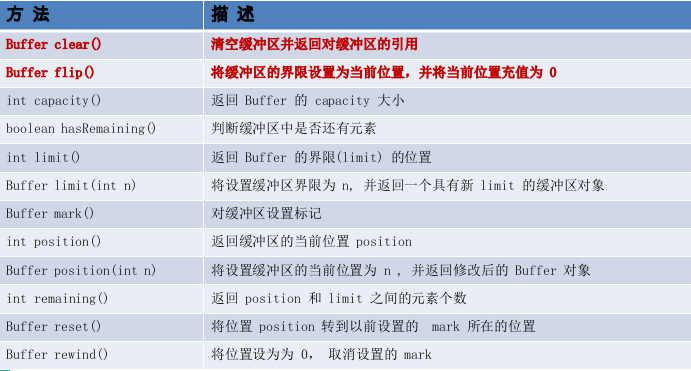
缓冲区的数据操作
Buffer 所有子类提供了两个用于数据操作的方法:get()
与 put() 方法
获取 Buffer 中的数据
get() :读取单个字节
get(byte[] dst):批量读取多个字节到 dst 中
get(int index):读取指定索引位置的字节(不会移动 position)
放入数据到 Buffer 中
put(byte b):将给定单个字节写入缓冲区的当前位置
put(byte[] src):将 src 中的字节写入缓冲区的当前位置
put(int index, byte b):将指定字节写入缓冲区的索引位置(不会移动 position)
直接与非直接缓冲区
字节缓冲区要么是直接的,要么是非直接的。如果为直接字节缓冲区,则 Java 虚拟机会尽最大努力直接在
此缓冲区上执行本机 I/O 操作。也就是说,在每次调用基础操作系统的一个本机 I/O 操作之前(或之后),
虚拟机都会尽量避免将缓冲区的内容复制到中间缓冲区中(或从中间缓冲区中复制内容)。
直接字节缓冲区可以通过调用此类的 allocateDirect() 工厂方法来创建。此方法返回的缓冲区进行分配和取消
分配所需成本通常高于非直接缓冲区。直接缓冲区的内容可以驻留在常规的垃圾回收堆之外,因此,它们对
应用程序的内存需求量造成的影响可能并不明显。所以,建议将直接缓冲区主要分配给那些易受基础系统的
本机 I/O 操作影响的大型、持久的缓冲区。一般情况下,最好仅在直接缓冲区能在程序性能方面带来明显好
处时分配它们。
直接字节缓冲区还可以通过 FileChannel 的 map() 方法 将文件区域直接映射到内存中来创建。该方法返回
MappedByteBuffer 。Java 平台的实现有助于通过 JNI 从本机代码创建直接字节缓冲区。如果以上这些缓冲区
中的某个缓冲区实例指的是不可访问的内存区域,则试图访问该区域不会更改该缓冲区的内容,并且将会在
访问期间或稍后的某个时间导致抛出不确定的异常。
字节缓冲区是直接缓冲区还是非直接缓冲区可通过调用其 isDirect() 方法来确定。提供此方法是为了能够在
性能关键型代码中执行显式缓冲区管理。
非直接缓冲区

直接缓冲区
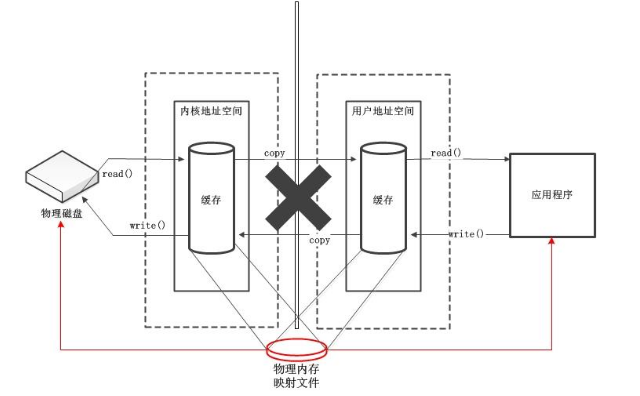


import java.nio.ByteBuffer; import org.junit.Test; /* * 一、缓冲区(Buffer):在 Java NIO 中负责数据的存取。缓冲区就是数组。用于存储不同数据类型的数据 * * 根据数据类型不同(boolean 除外),提供了相应类型的缓冲区: * ByteBuffer * CharBuffer * ShortBuffer * IntBuffer * LongBuffer * FloatBuffer * DoubleBuffer * * 上述缓冲区的管理方式几乎一致,通过 allocate() 获取缓冲区 * * 二、缓冲区存取数据的两个核心方法: * put() : 存入数据到缓冲区中 * get() : 获取缓冲区中的数据 * * 三、缓冲区中的四个核心属性: * capacity : 容量,表示缓冲区中最大存储数据的容量。一旦声明不能改变。 * limit : 界限,表示缓冲区中可以操作数据的大小。(limit 后数据不能进行读写) * position : 位置,表示缓冲区中正在操作数据的位置。 * * mark : 标记,表示记录当前 position 的位置。可以通过 reset() 恢复到 mark 的位置 * * 0 <= mark <= position <= limit <= capacity * * 四、直接缓冲区与非直接缓冲区: * 非直接缓冲区:通过 allocate() 方法分配缓冲区,将缓冲区建立在 JVM 的内存中 * 直接缓冲区:通过 allocateDirect() 方法分配直接缓冲区,将缓冲区建立在物理内存中。可以提高效率 */ public class TestBuffer { @Test public void test3(){ //分配直接缓冲区 ByteBuffer buf = ByteBuffer.allocateDirect(1024); System.out.println(buf.isDirect()); } @Test public void test2(){ String str = "abcde"; ByteBuffer buf = ByteBuffer.allocate(1024); buf.put(str.getBytes()); buf.flip(); byte[] dst = new byte[buf.limit()]; buf.get(dst, 0, 2); System.out.println(new String(dst, 0, 2)); System.out.println(buf.position()); //mark() : 标记 buf.mark(); buf.get(dst, 2, 2); System.out.println(new String(dst, 2, 2)); System.out.println(buf.position()); //reset() : 恢复到 mark 的位置 buf.reset(); System.out.println(buf.position()); //判断缓冲区中是否还有剩余数据 if(buf.hasRemaining()){ //获取缓冲区中可以操作的数量 System.out.println(buf.remaining()); } } @Test public void test1(){ String str = "abcde"; //1. 分配一个指定大小的缓冲区 ByteBuffer buf = ByteBuffer.allocate(1024); System.out.println("-----------------allocate()----------------"); System.out.println(buf.position()); System.out.println(buf.limit()); System.out.println(buf.capacity()); //2. 利用 put() 存入数据到缓冲区中 buf.put(str.getBytes()); System.out.println("-----------------put()----------------"); System.out.println(buf.position()); System.out.println(buf.limit()); System.out.println(buf.capacity()); //3. 切换读取数据模式 buf.flip(); System.out.println("-----------------flip()----------------"); System.out.println(buf.position()); System.out.println(buf.limit()); System.out.println(buf.capacity()); //4. 利用 get() 读取缓冲区中的数据 byte[] dst = new byte[buf.limit()]; buf.get(dst); System.out.println(new String(dst, 0, dst.length)); System.out.println("-----------------get()----------------"); System.out.println(buf.position()); System.out.println(buf.limit()); System.out.println(buf.capacity()); //5. rewind() : 可重复读 buf.rewind(); System.out.println("-----------------rewind()----------------"); System.out.println(buf.position()); System.out.println(buf.limit()); System.out.println(buf.capacity()); //6. clear() : 清空缓冲区. 但是缓冲区中的数据依然存在,但是处于“被遗忘”状态 buf.clear(); System.out.println("-----------------clear()----------------"); System.out.println(buf.position()); System.out.println(buf.limit()); System.out.println(buf.capacity()); System.out.println((char)buf.get()); } }
文件通道(FileChannel)
通道(Channel)
通道(Channel):由 java.nio.channels 包定义
的。Channel 表示 IO 源与目标打开的连接。
Channel 类似于传统的“流”。只不过 Channel
本身不能直接访问数据,Channel 只能与
Buffer 进行交互。


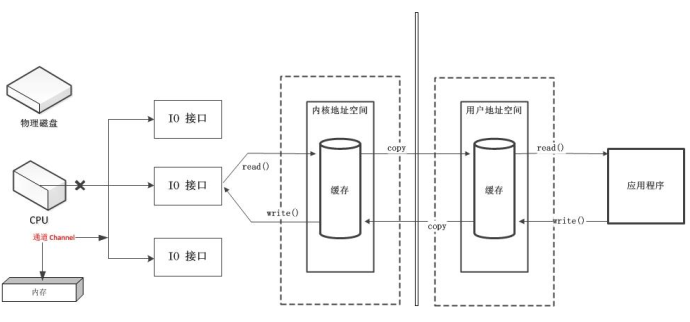
通道(Channel)
Java 为 Channel 接口提供的最主要实现类如下:
•FileChannel:用于读取、写入、映射和操作文件的通道。
•DatagramChannel:通过 UDP 读写网络中的数据通道。
•SocketChannel:通过 TCP 读写网络中的数据。
•ServerSocketChannel:可以监听新进来的 TCP 连接,对每一个新进来
的连接都会创建一个 SocketChannel。
获取通道
获取通道的一种方式是对支持通道的对象调用
getChannel() 方法。支持通道的类如下:
FileInputStream
FileOutputStream
RandomAccessFile
DatagramSocket
Socket
ServerSocket
获取通道的其他方式是使用 Files 类的静态方法 newByteChannel() 获
取字节通道。或者通过通道的静态方法 open() 打开并返回指定通道。
通道的数据传输
将 Buffer 中数据写入 Channel
例如
:
从 Channel 读取数据到 Buffer
例如:

分散(Scatter)和聚集(Gather)
分散读取(Scattering Reads)是指从 Channel 中读取的数据“分
散”到多个 Buffer 中。
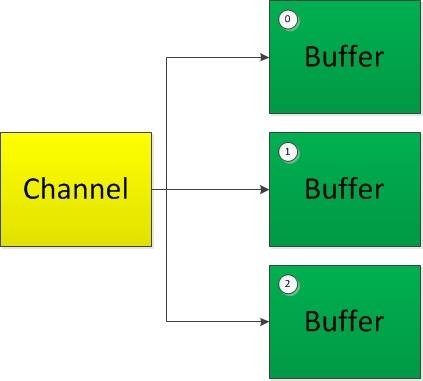
注意:按照缓冲区的顺序,从 Channel 中读取的数据依次将 Buffer 填满。
聚集写入(Gathering Writes)是指将多个 Buffer 中的数据“聚集”
到 Channel。
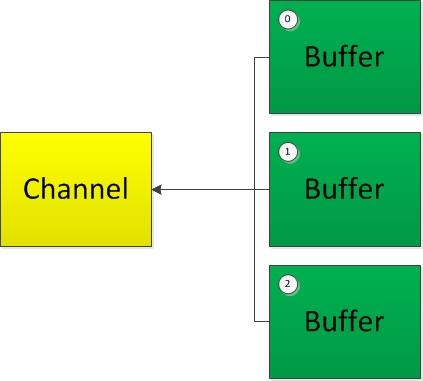
注意:按照缓冲区的顺序,写入 position 和 limit 之间的数据到 Channel 。
transferFrom()
将数据从源通道传输到其他 Channel 中:
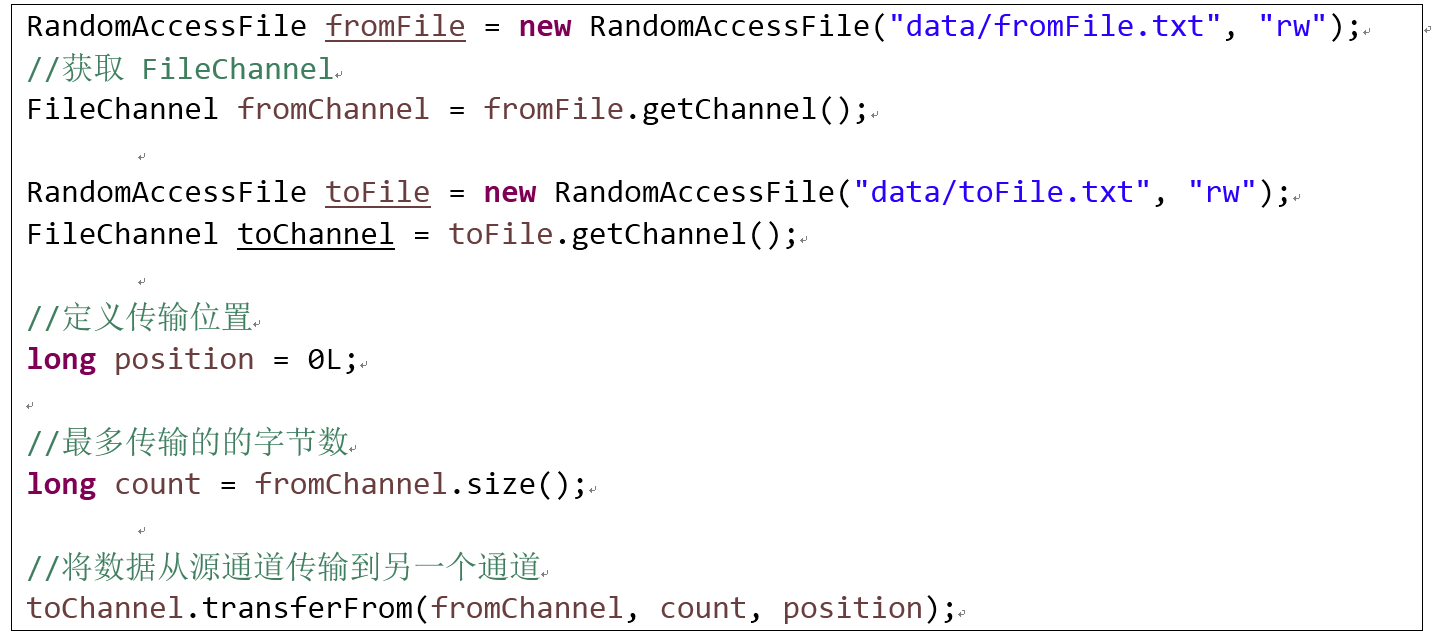
transferTo()
将数据从源通道传输到其他 Channel 中:

FileChannel 的常用方法
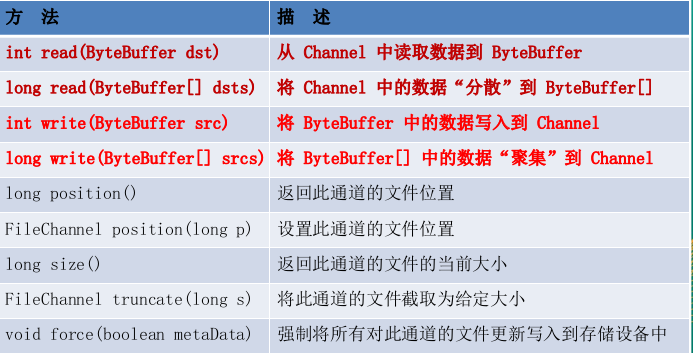

import java.io.FileInputStream; import java.io.FileOutputStream; import java.io.IOException; import java.io.RandomAccessFile; import java.nio.ByteBuffer; import java.nio.CharBuffer; import java.nio.MappedByteBuffer; import java.nio.channels.FileChannel; import java.nio.channels.FileChannel.MapMode; import java.nio.charset.CharacterCodingException; import java.nio.charset.Charset; import java.nio.charset.CharsetDecoder; import java.nio.charset.CharsetEncoder; import java.nio.file.Paths; import java.nio.file.StandardOpenOption; import java.util.Map; import java.util.Map.Entry; import java.util.Set; import org.junit.Test; /* * 一、通道(Channel):用于源节点与目标节点的连接。在 Java NIO 中负责缓冲区中数据的传输。Channel 本身不存储数据,因此需要配合缓冲区进行传输。 * * 二、通道的主要实现类 * java.nio.channels.Channel 接口: * |--FileChannel * |--SocketChannel * |--ServerSocketChannel * |--DatagramChannel * * 三、获取通道 * 1. Java 针对支持通道的类提供了 getChannel() 方法 * 本地 IO: * FileInputStream/FileOutputStream * RandomAccessFile * * 网络IO: * Socket * ServerSocket * DatagramSocket * * 2. 在 JDK 1.7 中的 NIO.2 针对各个通道提供了静态方法 open() * 3. 在 JDK 1.7 中的 NIO.2 的 Files 工具类的 newByteChannel() * * 四、通道之间的数据传输 * transferFrom() * transferTo() * * 五、分散(Scatter)与聚集(Gather) * 分散读取(Scattering Reads):将通道中的数据分散到多个缓冲区中 * 聚集写入(Gathering Writes):将多个缓冲区中的数据聚集到通道中 * * 六、字符集:Charset * 编码:字符串 -> 字节数组 * 解码:字节数组 -> 字符串 * */ public class TestChannel { //字符集 @Test public void test6() throws IOException{ Charset cs1 = Charset.forName("GBK"); //获取编码器 CharsetEncoder ce = cs1.newEncoder(); //获取解码器 CharsetDecoder cd = cs1.newDecoder(); CharBuffer cBuf = CharBuffer.allocate(1024); cBuf.put("尚硅谷威武!"); cBuf.flip(); //编码 ByteBuffer bBuf = ce.encode(cBuf); for (int i = 0; i < 12; i++) { System.out.println(bBuf.get()); } //解码 bBuf.flip(); CharBuffer cBuf2 = cd.decode(bBuf); System.out.println(cBuf2.toString()); System.out.println("------------------------------------------------------"); Charset cs2 = Charset.forName("GBK"); bBuf.flip(); CharBuffer cBuf3 = cs2.decode(bBuf); System.out.println(cBuf3.toString()); } @Test public void test5(){ Map<String, Charset> map = Charset.availableCharsets(); Set<Entry<String, Charset>> set = map.entrySet(); for (Entry<String, Charset> entry : set) { System.out.println(entry.getKey() + "=" + entry.getValue()); } } //分散和聚集 @Test public void test4() throws IOException{ RandomAccessFile raf1 = new RandomAccessFile("1.txt", "rw"); //1. 获取通道 FileChannel channel1 = raf1.getChannel(); //2. 分配指定大小的缓冲区 ByteBuffer buf1 = ByteBuffer.allocate(100); ByteBuffer buf2 = ByteBuffer.allocate(1024); //3. 分散读取 ByteBuffer[] bufs = {buf1, buf2}; channel1.read(bufs); for (ByteBuffer byteBuffer : bufs) { byteBuffer.flip(); } System.out.println(new String(bufs[0].array(), 0, bufs[0].limit())); System.out.println("-----------------"); System.out.println(new String(bufs[1].array(), 0, bufs[1].limit())); //4. 聚集写入 RandomAccessFile raf2 = new RandomAccessFile("2.txt", "rw"); FileChannel channel2 = raf2.getChannel(); channel2.write(bufs); } //通道之间的数据传输(直接缓冲区) @Test public void test3() throws IOException{ FileChannel inChannel = FileChannel.open(Paths.get("d:/1.mkv"), StandardOpenOption.READ); FileChannel outChannel = FileChannel.open(Paths.get("d:/2.mkv"), StandardOpenOption.WRITE, StandardOpenOption.READ, StandardOpenOption.CREATE); // inChannel.transferTo(0, inChannel.size(), outChannel); outChannel.transferFrom(inChannel, 0, inChannel.size()); inChannel.close(); outChannel.close(); } //使用直接缓冲区完成文件的复制(内存映射文件) @Test public void test2() throws IOException{//2127-1902-1777 long start = System.currentTimeMillis(); FileChannel inChannel = FileChannel.open(Paths.get("d:/1.mkv"), StandardOpenOption.READ); FileChannel outChannel = FileChannel.open(Paths.get("d:/2.mkv"), StandardOpenOption.WRITE, StandardOpenOption.READ, StandardOpenOption.CREATE); //内存映射文件 MappedByteBuffer inMappedBuf = inChannel.map(MapMode.READ_ONLY, 0, inChannel.size()); MappedByteBuffer outMappedBuf = outChannel.map(MapMode.READ_WRITE, 0, inChannel.size()); //直接对缓冲区进行数据的读写操作 byte[] dst = new byte[inMappedBuf.limit()]; inMappedBuf.get(dst); outMappedBuf.put(dst); inChannel.close(); outChannel.close(); long end = System.currentTimeMillis(); System.out.println("耗费时间为:" + (end - start)); } //利用通道完成文件的复制(非直接缓冲区) @Test public void test1(){//10874-10953 long start = System.currentTimeMillis(); FileInputStream fis = null; FileOutputStream fos = null; //①获取通道 FileChannel inChannel = null; FileChannel outChannel = null; try { fis = new FileInputStream("d:/1.mkv"); fos = new FileOutputStream("d:/2.mkv"); inChannel = fis.getChannel(); outChannel = fos.getChannel(); //②分配指定大小的缓冲区 ByteBuffer buf = ByteBuffer.allocate(1024); //③将通道中的数据存入缓冲区中 while(inChannel.read(buf) != -1){ buf.flip(); //切换读取数据的模式 //④将缓冲区中的数据写入通道中 outChannel.write(buf); buf.clear(); //清空缓冲区 } } catch (IOException e) { e.printStackTrace(); } finally { if(outChannel != null){ try { outChannel.close(); } catch (IOException e) { e.printStackTrace(); } } if(inChannel != null){ try { inChannel.close(); } catch (IOException e) { e.printStackTrace(); } } if(fos != null){ try { fos.close(); } catch (IOException e) { e.printStackTrace(); } } if(fis != null){ try { fis.close(); } catch (IOException e) { e.printStackTrace(); } } } long end = System.currentTimeMillis(); System.out.println("耗费时间为:" + (end - start)); }
NIO 的非阻塞式网络通信
阻塞与非阻塞
传统的 IO 流都是阻塞式的。也就是说,当一个线程调用 read() 或 write()
时,该线程被阻塞,直到有一些数据被读取或写入,该线程在此期间不
能执行其他任务。因此,在完成网络通信进行 IO 操作时,由于线程会
阻塞,所以服务器端必须为每个客户端都提供一个独立的线程进行处理,
当服务器端需要处理大量客户端时,性能急剧下降。
Java NIO 是非阻塞模式的。当线程从某通道进行读写数据时,若没有数
据可用时,该线程可以进行其他任务。线程通常将非阻塞 IO 的空闲时
间用于在其他通道上执行 IO 操作,所以单独的线程可以管理多个输入
和输出通道。因此,NIO 可以让服务器端使用一个或有限几个线程来同
时处理连接到服务器端的所有客户端。
选择器(Selector)
是 SelectableChannle 对象的多路复用器,Selector 可
以同时监控多个 SelectableChannel 的 IO 状况,也就是说,利用 Selector
可使一个单独的线程管理多个 Channel。Selector 是非阻塞 IO 的核心。
SelectableChannle 的结构如下图:
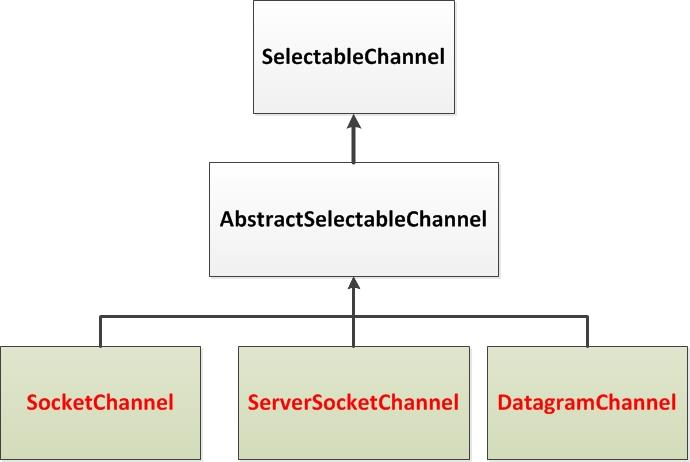
选择器(Selector)的应用
创建 Selector :通过调用 Selector.open() 方法创建一个 Selector。

向选择器注册通道:SelectableChannel.register(Selector sel, int ops)
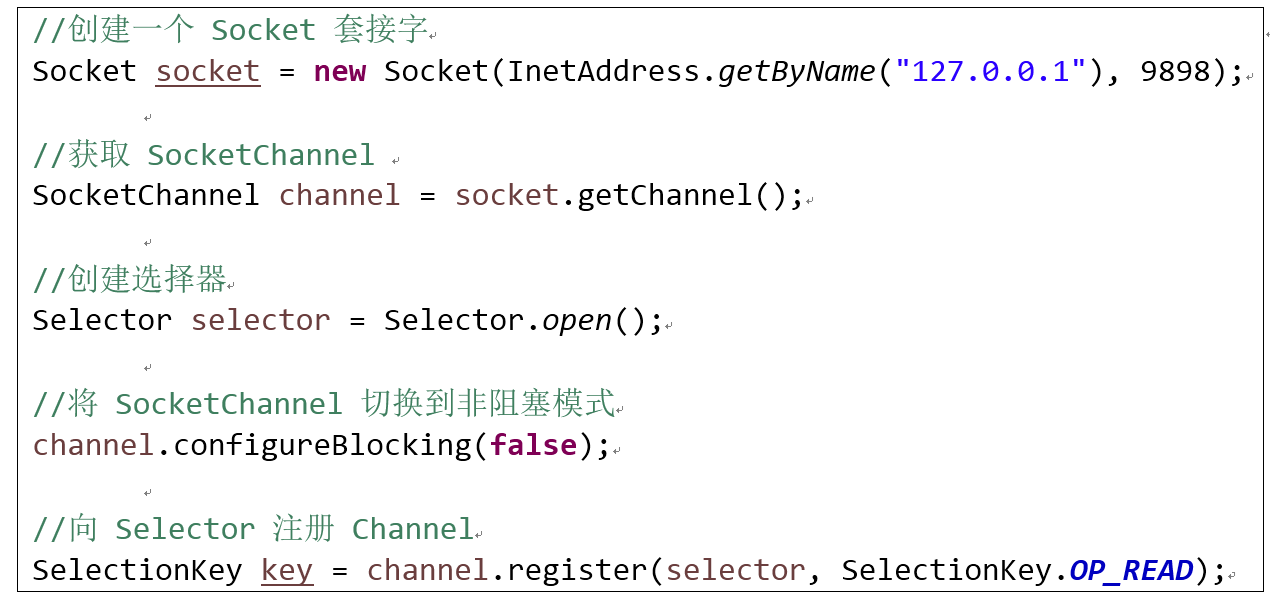
当调用 register(Selector sel, int ops) 将通道注册选择器时,选择器
对通道的监听事件,需要通过第二个参数 ops 指定。
可以监听的事件类型(可使用 SelectionKey 的四个常量表示):
读 : SelectionKey.OP_READ (1) 写 : SelectionKey.OP_WRITE (4) 连接 : SelectionKey.OP_CONNECT (8) 接收 : SelectionKey.OP_ACCEPT (16)
若注册时不止监听一个事件,则可以使用“位或”操作符连接。
例:

SelectionKey
当调用 register(Selector sel, int ops) 将通道注册选择器时,选择器
对通道的监听事件,需要通过第二个参数 ops 指定。
可以监听的事件类型(可使用 SelectionKey 的四个常量表示):
读 : SelectionKey.OP_READ (1) 写 : SelectionKey.OP_WRITE (4) 连接 : SelectionKey.OP_CONNECT (8) 接收 : SelectionKey.OP_ACCEPT (16)
若注册时不止监听一个事件,则可以使用“位或”操作符连接。
例:

SelectionKey:表示 SelectableChannel 和 Selector 之间的注册关系。每次向
选择器注册通道时就会选择一个事件(选择键)。选择键包含两个表示为整
数值的操作集。操作集的每一位都表示该键的通道所支持的一类可选择操
作。
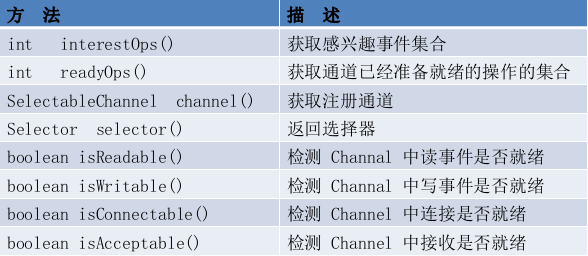

SocketChannel、ServerSocketChannel、DatagramChannel
SocketChannel
Java NIO中的SocketChannel是一个连接到TCP网
络套接字的通道。
操作步骤:
打开 SocketChannel
读写数据
关闭 SocketChannelSocketChannel
Java NIO中的 ServerSocketChannel 是一个可以
监听新进来的TCP连接的通道,就像标准IO中
的ServerSocket一样。DatagramChannel
Java NIO中的DatagramChannel是一个能收发
UDP包的通道。
操作步骤:
打开 DatagramChannel
接收/发送数据

import java.io.IOException; import java.net.InetSocketAddress; import java.nio.ByteBuffer; import java.nio.channels.FileChannel; import java.nio.channels.ServerSocketChannel; import java.nio.channels.SocketChannel; import java.nio.file.Paths; import java.nio.file.StandardOpenOption; import org.junit.Test; /* * 一、使用 NIO 完成网络通信的三个核心: * * 1. 通道(Channel):负责连接 * * java.nio.channels.Channel 接口: * |--SelectableChannel * |--SocketChannel * |--ServerSocketChannel * |--DatagramChannel * * |--Pipe.SinkChannel * |--Pipe.SourceChannel * * 2. 缓冲区(Buffer):负责数据的存取 * * 3. 选择器(Selector):是 SelectableChannel 的多路复用器。用于监控 SelectableChannel 的 IO 状况 * */ public class TestBlockingNIO { //客户端 @Test public void client() throws IOException{ //1. 获取通道 SocketChannel sChannel = SocketChannel.open(new InetSocketAddress("127.0.0.1", 9898)); FileChannel inChannel = FileChannel.open(Paths.get("1.jpg"), StandardOpenOption.READ); //2. 分配指定大小的缓冲区 ByteBuffer buf = ByteBuffer.allocate(1024); //3. 读取本地文件,并发送到服务端 while(inChannel.read(buf) != -1){ buf.flip(); sChannel.write(buf); buf.clear(); } //4. 关闭通道 inChannel.close(); sChannel.close(); } //服务端 @Test public void server() throws IOException{ //1. 获取通道 ServerSocketChannel ssChannel = ServerSocketChannel.open(); FileChannel outChannel = FileChannel.open(Paths.get("2.jpg"), StandardOpenOption.WRITE, StandardOpenOption.CREATE); //2. 绑定连接 ssChannel.bind(new InetSocketAddress(9898)); //3. 获取客户端连接的通道 SocketChannel sChannel = ssChannel.accept(); //4. 分配指定大小的缓冲区 ByteBuffer buf = ByteBuffer.allocate(1024); //5. 接收客户端的数据,并保存到本地 while(sChannel.read(buf) != -1){ buf.flip(); outChannel.write(buf); buf.clear(); } //6. 关闭通道 sChannel.close(); outChannel.close(); ssChannel.close(); } }

import java.io.IOException; import java.net.InetSocketAddress; import java.nio.ByteBuffer; import java.nio.channels.FileChannel; import java.nio.channels.ServerSocketChannel; import java.nio.channels.SocketChannel; import java.nio.file.Paths; import java.nio.file.StandardOpenOption; import org.junit.Test; public class TestBlockingNIO2 { //客户端 @Test public void client() throws IOException{ SocketChannel sChannel = SocketChannel.open(new InetSocketAddress("127.0.0.1", 9898)); FileChannel inChannel = FileChannel.open(Paths.get("1.jpg"), StandardOpenOption.READ); ByteBuffer buf = ByteBuffer.allocate(1024); while(inChannel.read(buf) != -1){ buf.flip(); sChannel.write(buf); buf.clear(); } sChannel.shutdownOutput(); //接收服务端的反馈 int len = 0; while((len = sChannel.read(buf)) != -1){ buf.flip(); System.out.println(new String(buf.array(), 0, len)); buf.clear(); } inChannel.close(); sChannel.close(); } //服务端 @Test public void server() throws IOException{ ServerSocketChannel ssChannel = ServerSocketChannel.open(); FileChannel outChannel = FileChannel.open(Paths.get("2.jpg"), StandardOpenOption.WRITE, StandardOpenOption.CREATE); ssChannel.bind(new InetSocketAddress(9898)); SocketChannel sChannel = ssChannel.accept(); ByteBuffer buf = ByteBuffer.allocate(1024); while(sChannel.read(buf) != -1){ buf.flip(); outChannel.write(buf); buf.clear(); } //发送反馈给客户端 buf.put("服务端接收数据成功".getBytes()); buf.flip(); sChannel.write(buf); sChannel.close(); outChannel.close(); ssChannel.close(); } }

import java.io.IOException; import java.net.InetSocketAddress; import java.nio.ByteBuffer; import java.nio.channels.SelectionKey; import java.nio.channels.Selector; import java.nio.channels.ServerSocketChannel; import java.nio.channels.SocketChannel; import java.util.Date; import java.util.Iterator; import java.util.Scanner; import org.junit.Test; /* * 一、使用 NIO 完成网络通信的三个核心: * * 1. 通道(Channel):负责连接 * * java.nio.channels.Channel 接口: * |--SelectableChannel * |--SocketChannel * |--ServerSocketChannel * |--DatagramChannel * * |--Pipe.SinkChannel * |--Pipe.SourceChannel * * 2. 缓冲区(Buffer):负责数据的存取 * * 3. 选择器(Selector):是 SelectableChannel 的多路复用器。用于监控 SelectableChannel 的 IO 状况 * */ public class TestNonBlockingNIO { //客户端 @Test public void client() throws IOException{ //1. 获取通道 SocketChannel sChannel = SocketChannel.open(new InetSocketAddress("127.0.0.1", 9898)); //2. 切换非阻塞模式 sChannel.configureBlocking(false); //3. 分配指定大小的缓冲区 ByteBuffer buf = ByteBuffer.allocate(1024); //4. 发送数据给服务端 Scanner scan = new Scanner(System.in); while(scan.hasNext()){ String str = scan.next(); buf.put((new Date().toString() + " " + str).getBytes()); buf.flip(); sChannel.write(buf); buf.clear(); } //5. 关闭通道 sChannel.close(); } //服务端 @Test public void server() throws IOException{ //1. 获取通道 ServerSocketChannel ssChannel = ServerSocketChannel.open(); //2. 切换非阻塞模式 ssChannel.configureBlocking(false); //3. 绑定连接 ssChannel.bind(new InetSocketAddress(9898)); //4. 获取选择器 Selector selector = Selector.open(); //5. 将通道注册到选择器上, 并且指定“监听接收事件” ssChannel.register(selector, SelectionKey.OP_ACCEPT); //6. 轮询式的获取选择器上已经“准备就绪”的事件 while(selector.select() > 0){ //7. 获取当前选择器中所有注册的“选择键(已就绪的监听事件)” Iterator<SelectionKey> it = selector.selectedKeys().iterator(); while(it.hasNext()){ //8. 获取准备“就绪”的是事件 SelectionKey sk = it.next(); //9. 判断具体是什么事件准备就绪 if(sk.isAcceptable()){ //10. 若“接收就绪”,获取客户端连接 SocketChannel sChannel = ssChannel.accept(); //11. 切换非阻塞模式 sChannel.configureBlocking(false); //12. 将该通道注册到选择器上 sChannel.register(selector, SelectionKey.OP_READ); }else if(sk.isReadable()){ //13. 获取当前选择器上“读就绪”状态的通道 SocketChannel sChannel = (SocketChannel) sk.channel(); //14. 读取数据 ByteBuffer buf = ByteBuffer.allocate(1024); int len = 0; while((len = sChannel.read(buf)) > 0 ){ buf.flip(); System.out.println(new String(buf.array(), 0, len)); buf.clear(); } } //15. 取消选择键 SelectionKey it.remove(); } } } }

import java.io.IOException; import java.net.InetSocketAddress; import java.nio.ByteBuffer; import java.nio.channels.DatagramChannel; import java.nio.channels.SelectionKey; import java.nio.channels.Selector; import java.util.Date; import java.util.Iterator; import java.util.Scanner; import org.junit.Test; public class TestNonBlockingNIO2 { @Test public void send() throws IOException{ DatagramChannel dc = DatagramChannel.open(); dc.configureBlocking(false); ByteBuffer buf = ByteBuffer.allocate(1024); Scanner scan = new Scanner(System.in); while(scan.hasNext()){ String str = scan.next(); buf.put((new Date().toString() + ": " + str).getBytes()); buf.flip(); dc.send(buf, new InetSocketAddress("127.0.0.1", 9898)); buf.clear(); } dc.close(); } @Test public void receive() throws IOException{ DatagramChannel dc = DatagramChannel.open(); dc.configureBlocking(false); dc.bind(new InetSocketAddress(9898)); Selector selector = Selector.open(); dc.register(selector, SelectionKey.OP_READ); while(selector.select() > 0){ Iterator<SelectionKey> it = selector.selectedKeys().iterator(); while(it.hasNext()){ SelectionKey sk = it.next(); if(sk.isReadable()){ ByteBuffer buf = ByteBuffer.allocate(1024); dc.receive(buf); buf.flip(); System.out.println(new String(buf.array(), 0, buf.limit())); buf.clear(); } } it.remove(); } } }
管道 (Pipe)
Java NIO 管道是2个线程之间的单向数据连接。
Pipe有一个source通道和一个sink通道。数据会
被写到sink通道,从source通道读取。

向管道写数据
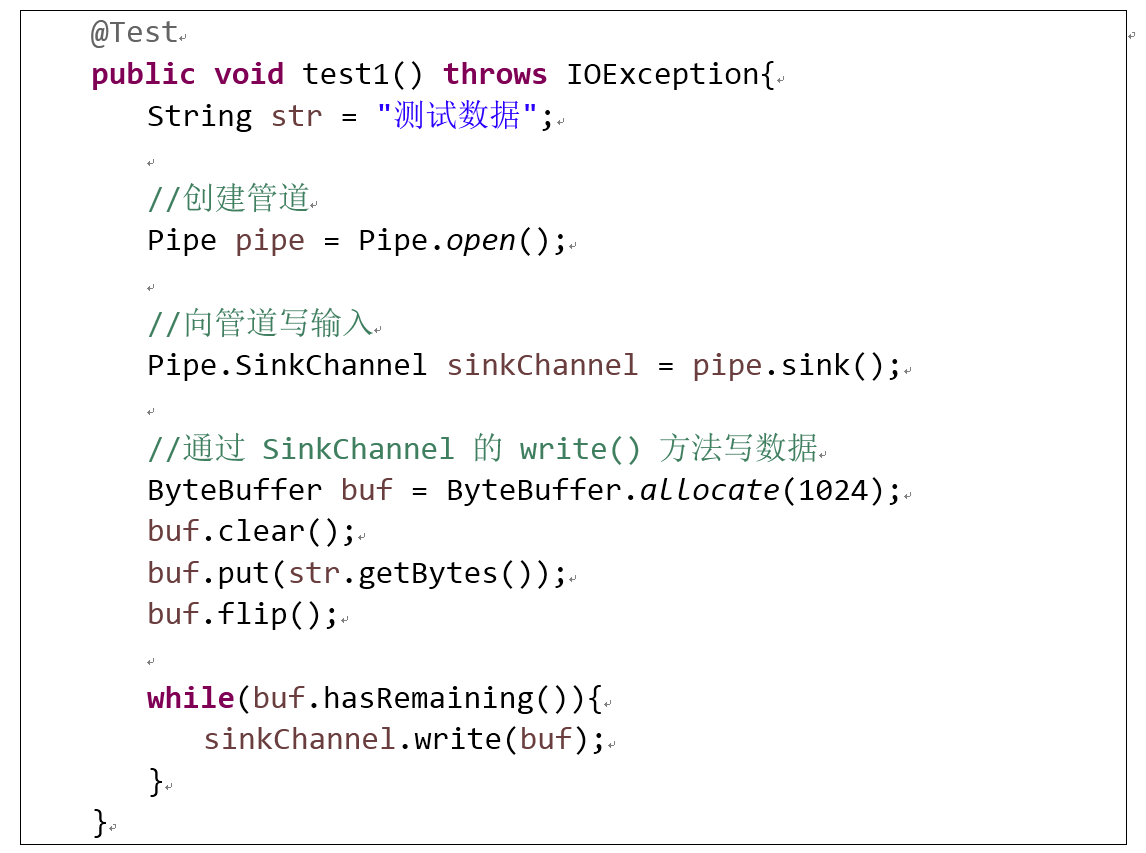
从管道读取数据
• 从读取管道的数据,需要访问source通道。

• 调用source通道的read()方法来读取数据


import java.io.IOException; import java.nio.ByteBuffer; import java.nio.channels.Pipe; import org.junit.Test; public class TestPipe { @Test public void test1() throws IOException{ //1. 获取管道 Pipe pipe = Pipe.open(); //2. 将缓冲区中的数据写入管道 ByteBuffer buf = ByteBuffer.allocate(1024); Pipe.SinkChannel sinkChannel = pipe.sink(); buf.put("通过单向管道发送数据".getBytes()); buf.flip(); sinkChannel.write(buf); //3. 读取缓冲区中的数据 Pipe.SourceChannel sourceChannel = pipe.source(); buf.flip(); int len = sourceChannel.read(buf); System.out.println(new String(buf.array(), 0, len)); sourceChannel.close(); sinkChannel.close(); } }
3-NIO.2 – Path、Paths、Files
NIO.2
随着 JDK 7 的发布,Java对NIO进行了极大的扩
展,增强了对文件处理和文件系统特性的支持,
以至于我们称他们为 NIO.2。因为 NIO 提供的
一些功能,NIO已经成为文件处理中越来越重
要的部分。Path 与 Paths
java.nio.file.Path 接口代表一个平台无关的平台路径,描述了目
录结构中文件的位置。
Paths 提供的 get() 方法用来获取 Path 对象:
Path get(String first, String ... more) : 用于将多个字符串串连成路径。
Path 常用方法:
boolean endsWith(String path) : 判断是否以 path 路径结束 boolean startsWith(String path) : 判断是否以 path 路径开始 boolean isAbsolute() : 判断是否是绝对路径 Path getFileName() : 返回与调用 Path 对象关联的文件名 Path getName(int idx) : 返回的指定索引位置 idx 的路径名称 int getNameCount() : 返回Path 根目录后面元素的数量 Path getParent() :返回Path对象包含整个路径,不包含 Path 对象指定的文件路径 Path getRoot() :返回调用 Path 对象的根路径 Path resolve(Path p) :将相对路径解析为绝对路径 Path toAbsolutePath() : 作为绝对路径返回调用 Path 对象 String toString() : 返回调用 Path 对象的字符串表示形式Files 类 java.nio.file.Files 用于操作文件或目录的工具类。
Files常用方法:
Path copy(Path src, Path dest, CopyOption ... how) : 文件的复制 Path createDirectory(Path path, FileAttribute<?> ... attr) : 创建一个目录 Path createFile(Path path, FileAttribute<?> ... arr) : 创建一个文件 void delete(Path path) : 删除一个文件 Path move(Path src, Path dest, CopyOption...how) : 将 src 移动到 dest 位置 long size(Path path) : 返回 path 指定文件的大小Files 类
Files常用方法:用于判断
boolean exists(Path path, LinkOption ... opts) : 判断文件是否存在 boolean isDirectory(Path path, LinkOption ... opts) : 判断是否是目录 boolean isExecutable(Path path) : 判断是否是可执行文件 boolean isHidden(Path path) : 判断是否是隐藏文件 boolean isReadable(Path path) : 判断文件是否可读 boolean isWritable(Path path) : 判断文件是否可写 boolean notExists(Path path, LinkOption ... opts) : 判断文件是否不存在 public static <A extends BasicFileAttributes> A readAttributes(Path path,Class<A> type,LinkOption... options) : 获取与 path 指定的文件相关联的属性。
Files常用方法:用于操作内容
SeekableByteChannel newByteChannel(Path path, OpenOption...how) : 获取与指定文件的连接,
how 指定打开方式。
DirectoryStream newDirectoryStream(Path path) : 打开 path 指定的目录
InputStream newInputStream(Path path, OpenOption...how):获取 InputStream 对象
OutputStream newOutputStream(Path path, OpenOption...how) : 获取 OutputStream 对象自动资源管理
Java 7 增加了一个新特性,该特性提供了另外
一种管理资源的方式,这种方式能自动关闭文
件。这个特性有时被称为自动资源管理
(Automatic Resource Management, ARM), 该特
性以 try 语句的扩展版为基础。自动资源管理
主要用于,当不再需要文件(或其他资源)时,
可以防止无意中忘记释放它们。自动资源管理
自动资源管理基于 try 语句的扩展形式:

try(需要关闭的资源声明){ //可能发生异常的语句 }catch(异常类型 变量名){ //异常的处理语句 } ...... finally{ //一定执行的语句 }
当 try 代码块结束时,自动释放资源。因此不需要显示的调用 close() 方法。该形式也称为“带资源的 try 语句”。
注意:
1try 语句中声明的资源被隐式声明为 final ,资源的作用局限于带资源的 try
语句
2可以在一条 try 语句中管理多个资源,每个资源以“;” 隔开即可。
3需要关闭的资源,必须实现了 AutoCloseable 接口或其自接口 Closeable

import java.io.IOException; import java.nio.ByteBuffer; import java.nio.channels.FileChannel; import java.nio.channels.SeekableByteChannel; import java.nio.file.DirectoryStream; import java.nio.file.Files; import java.nio.file.LinkOption; import java.nio.file.Path; import java.nio.file.Paths; import java.nio.file.StandardCopyOption; import java.nio.file.StandardOpenOption; import java.nio.file.attribute.BasicFileAttributes; import java.nio.file.attribute.DosFileAttributeView; import org.junit.Test; public class TestNIO_2 { //自动资源管理:自动关闭实现 AutoCloseable 接口的资源 @Test public void test8(){ try(FileChannel inChannel = FileChannel.open(Paths.get("1.jpg"), StandardOpenOption.READ); FileChannel outChannel = FileChannel.open(Paths.get("2.jpg"), StandardOpenOption.WRITE, StandardOpenOption.CREATE)){ ByteBuffer buf = ByteBuffer.allocate(1024); inChannel.read(buf); }catch(IOException e){ } } /* Files常用方法:用于操作内容 SeekableByteChannel newByteChannel(Path path, OpenOption…how) : 获取与指定文件的连接,how 指定打开方式。 DirectoryStream newDirectoryStream(Path path) : 打开 path 指定的目录 InputStream newInputStream(Path path, OpenOption…how):获取 InputStream 对象 OutputStream newOutputStream(Path path, OpenOption…how) : 获取 OutputStream 对象 */ @Test public void test7() throws IOException{ SeekableByteChannel newByteChannel = Files.newByteChannel(Paths.get("1.jpg"), StandardOpenOption.READ); DirectoryStream<Path> newDirectoryStream = Files.newDirectoryStream(Paths.get("e:/")); for (Path path : newDirectoryStream) { System.out.println(path); } } /* Files常用方法:用于判断 boolean exists(Path path, LinkOption … opts) : 判断文件是否存在 boolean isDirectory(Path path, LinkOption … opts) : 判断是否是目录 boolean isExecutable(Path path) : 判断是否是可执行文件 boolean isHidden(Path path) : 判断是否是隐藏文件 boolean isReadable(Path path) : 判断文件是否可读 boolean isWritable(Path path) : 判断文件是否可写 boolean notExists(Path path, LinkOption … opts) : 判断文件是否不存在 public static <A extends BasicFileAttributes> A readAttributes(Path path,Class<A> type,LinkOption... options) : 获取与 path 指定的文件相关联的属性。 */ @Test public void test6() throws IOException{ Path path = Paths.get("e:/nio/hello7.txt"); // System.out.println(Files.exists(path, LinkOption.NOFOLLOW_LINKS)); BasicFileAttributes readAttributes = Files.readAttributes(path, BasicFileAttributes.class, LinkOption.NOFOLLOW_LINKS); System.out.println(readAttributes.creationTime()); System.out.println(readAttributes.lastModifiedTime()); DosFileAttributeView fileAttributeView = Files.getFileAttributeView(path, DosFileAttributeView.class, LinkOption.NOFOLLOW_LINKS); fileAttributeView.setHidden(false); } /* Files常用方法: Path copy(Path src, Path dest, CopyOption … how) : 文件的复制 Path createDirectory(Path path, FileAttribute<?> … attr) : 创建一个目录 Path createFile(Path path, FileAttribute<?> … arr) : 创建一个文件 void delete(Path path) : 删除一个文件 Path move(Path src, Path dest, CopyOption…how) : 将 src 移动到 dest 位置 long size(Path path) : 返回 path 指定文件的大小 */ @Test public void test5() throws IOException{ Path path1 = Paths.get("e:/nio/hello2.txt"); Path path2 = Paths.get("e:/nio/hello7.txt"); System.out.println(Files.size(path2)); // Files.move(path1, path2, StandardCopyOption.ATOMIC_MOVE); } @Test public void test4() throws IOException{ Path dir = Paths.get("e:/nio/nio2"); // Files.createDirectory(dir); Path file = Paths.get("e:/nio/nio2/hello3.txt"); // Files.createFile(file); Files.deleteIfExists(file); } @Test public void test3() throws IOException{ Path path1 = Paths.get("e:/nio/hello.txt"); Path path2 = Paths.get("e:/nio/hello2.txt"); Files.copy(path1, path2, StandardCopyOption.REPLACE_EXISTING); } /* Paths 提供的 get() 方法用来获取 Path 对象: Path get(String first, String … more) : 用于将多个字符串串连成路径。 Path 常用方法: boolean endsWith(String path) : 判断是否以 path 路径结束 boolean startsWith(String path) : 判断是否以 path 路径开始 boolean isAbsolute() : 判断是否是绝对路径 Path getFileName() : 返回与调用 Path 对象关联的文件名 Path getName(int idx) : 返回的指定索引位置 idx 的路径名称 int getNameCount() : 返回Path 根目录后面元素的数量 Path getParent() :返回Path对象包含整个路径,不包含 Path 对象指定的文件路径 Path getRoot() :返回调用 Path 对象的根路径 Path resolve(Path p) :将相对路径解析为绝对路径 Path toAbsolutePath() : 作为绝对路径返回调用 Path 对象 String toString() : 返回调用 Path 对象的字符串表示形式 */ @Test public void test2(){ Path path = Paths.get("e:/nio/hello.txt"); System.out.println(path.getParent()); System.out.println(path.getRoot()); // Path newPath = path.resolve("e:/hello.txt"); // System.out.println(newPath); Path path2 = Paths.get("1.jpg"); Path newPath = path2.toAbsolutePath(); System.out.println(newPath); System.out.println(path.toString()); } @Test public void test1(){ Path path = Paths.get("e:/", "nio/hello.txt"); System.out.println(path.endsWith("hello.txt")); System.out.println(path.startsWith("e:/")); System.out.println(path.isAbsolute()); System.out.println(path.getFileName()); for (int i = 0; i < path.getNameCount(); i++) { System.out.println(path.getName(i)); } } }
